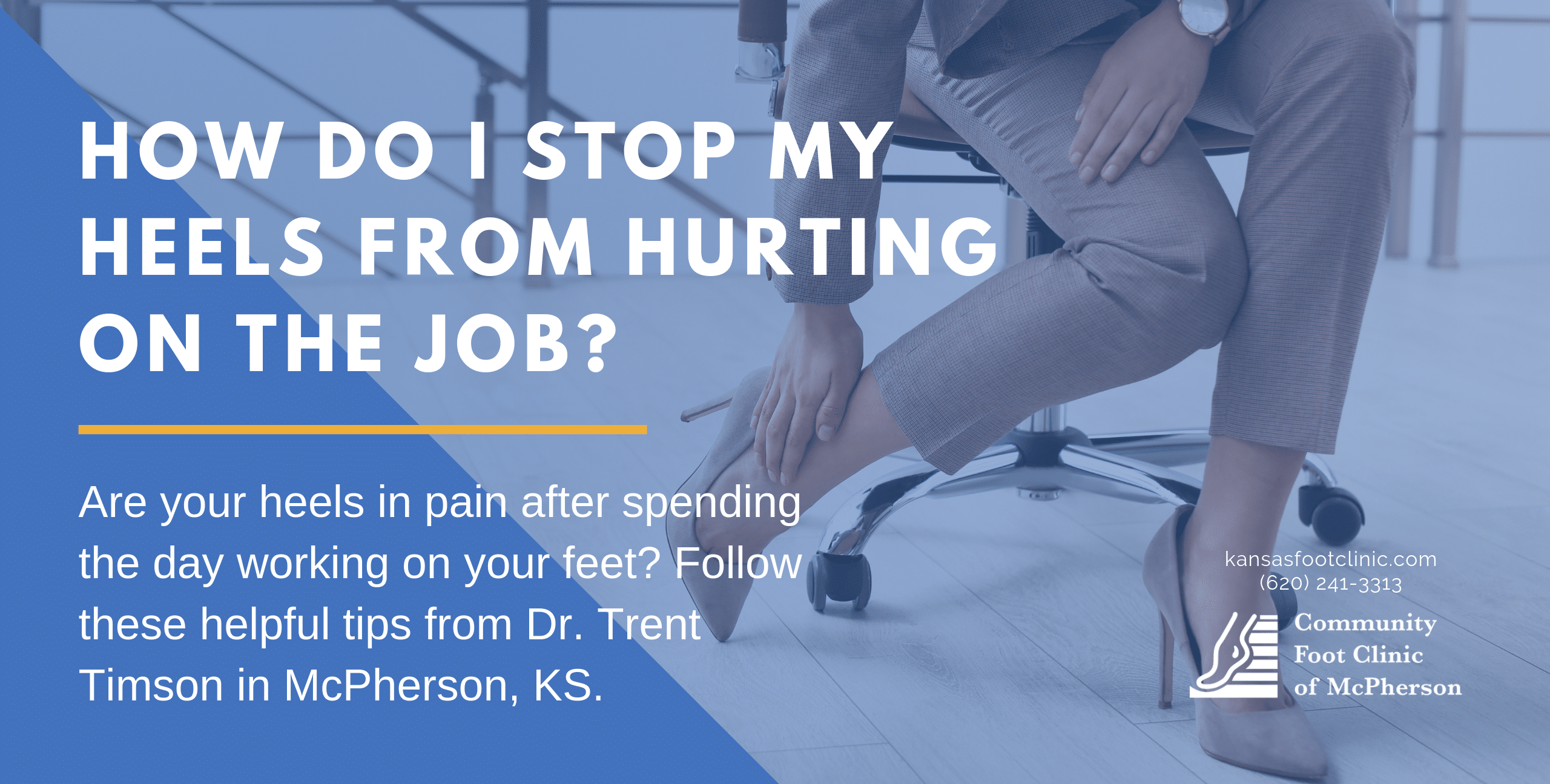How Do I Stop My Heels From Hurting On the Job?
If you work on your feet, you can’t afford to let something like heel pain slow you down.
And here in Central Kansas, most folks do work on their feet. Equipment manufacturing. Agriculture. Construction. Energy. Health care. Pharmaceuticals. Education. A huge chunk of our local economy depends on men and women who spend a lot more time standing and walking than sitting at a desk!
Unfortunately, highly physical jobs not only make heel pain more likely to develop, but also more stubborn and difficult to treat. For many of us, simply taking a few days (or weeks) to “rest” isn’t really an option, so the pain never really gets better—at least not for long.
And of course, you can’t exactly escape your heel pain after you clock out for the day. So when you get home you’re more likely to crash on the couch until bedtime than pursue more active hobbies or work around the house.
Is there a way to break this vicious cycle?
Yes!
Heel pain is never normal, even for people who spend all day on their feet. Here are some ways that you can help manage and prevent it.
Wear the Right Shoes
This should absolutely be at the top of your list. Shoes aren’t just a fashion statement. They’re the most important tools you have to combat chronic heel pain.
Yes, our feet are designed to keep us upright most of the day. But spending all day on surfaces like concrete, tile, and other completely flat and unforgiving surfaces? That’s an extra challenge that we’ve brought upon ourselves!
So what shoe is best? That depends to some degree on your foot shape, as well as the physical demands of your job. But in general terms, here’s what to look for:
- Comfort. Your shoes should feel good on your feet.
- A good fit. You’re looking for something that’s firm (but not too tight) in the heel to prevent sliding around, with good wiggle room in the toes and about half an inch of space between the longest toe and the front of the shoe.
- Great cushioning and arch support. Without these elements, your shoes really aren’t going to do you much good in the shock absorption / pressure offloading department.
- A slightly elevated heel. Flats are no good for prolonged standing. A quarter to a half inch of elevation will be ideal.
One more quick tip—you should own at least two (and ideally three) pairs of work shoes so that you can rotate through them. Although this won’t necessarily do anything about your heel pain, it will reduce your risk of developing foot odor or fungal infections!
Improve Your Workstation
This advice may not work for you if you never stay in one spot for long periods of time while on the job. But if you do have a particular workstation where you spend a lot of time standing in place (teachers, assembly line workers, cashiers, cooks, etc.), you can often make a few adjustments to reduce the foot strain.
The most obvious would be an anti-fatigue floor mat for your workstation. They come in all kinds of shapes, sizes, and materials, but what they have in common is that they all add one more layer of cushioning between the hard floor and your feet. It’s almost like having an extra shoe.
Another possible option would be seeing if you can get a chair or stool to sit on at least part of the time. You don’t want to be sitting all day either, but being able to alternate between sitting and standing as needed can really help your heels and legs to stay fresh.
Take Time to Stretch
A full day on your feet can not only lead to stiff and sore muscles, but even cause blood to pool in your feet and lower legs. Heel pain, cramping, numbness, and other symptoms may be the result.
One way you can help combat this is by taking time to rest and stretch your legs, ideally once per hour or so. Some stretches you can try include:
- Calf raises. Stand on the edge of a step or sturdy platform, if one is available, with the balls of your feet on the step and your heels hanging over the side. Raise up on your tip toes, hold, then slowly lower back down.
- Standing calf stretch (also known as the “runner’s stretch”). Place your hands on the wall in front of you. Extend one leg backward, keeping the knee straight, as far as it will go with the heel planting firmly on the floor. Hold and switch.
- Knee flexes. Hold a table or wall for support if you need it, then slowly bend one knee and lift your heel up toward your buttocks. Hold, then slowly lower it again.
- Plantar fascia stretch. Take a seat and cross one leg over the opposite knee. Reach over with your arm to grasp the big toe, then gently pull it toward yourself. Hold and switch.
Make an Appointment with Your Podiatrist
If your attempts to manage your heel pain on your own at work aren’t cutting it, make sure you stop in to see Dr. Trent Timson at the Community Foot Clinic of McPherson.
We have a lot of additional resources and treatments that can help, including:
- Arch supports and/or custom orthotics. In some cases, a supportive pair of shoes may not be enough on its own—especially if you have flat feet, high arches, or any other structural abnormalities with your feet. Instead of trying to pick a cheap insole off the rack at random, come to our office. We can either select an appropriate prefabricated device for you, or help fit you for custom orthotic devices.
- Injection therapy. Targeted injections of a corticosteroid can provide 3-6 months of sustained pain relief on average—during which time you can try to help the original injury to heal by using proper shoes, orthotics, and stretching.
- MLS laser treatment. This is one of the most advanced treatments available in medicine today to deal with chronic heel pain. The laser brings about a rapid pain relief response, followed by a reduction in swelling and an acceleration of the body’s natural healing processes. It’s a good choice for those with pain that hasn’t responded to other treatments, as well as workers who can’t afford a long period of lower productivity and just want to get better as quickly as possible.
We said it already, but we’ll say it again—heel pain is not normal and not inevitable, even for those with physically demanding jobs. And we can absolutely help you to reduce or even eliminate it, so that you can get through your workday with less pain and more energy to do the things you truly love to do.
To schedule an appointment with us at one of our three convenient offices, please give us a call at (620) 241-3313. Same-day appointments are often available for new patients!
McPherson Office
316 W. 4th Street
McPherson, KS 67460
P: (620) 241-3313
F: (620) 241-6967
© Community Foot Clinic of McPherson. All Rights Reserved.
Privacy Policy | Terms & Conditions
Web Design by CP Solutions
Marketed by VMD Services


